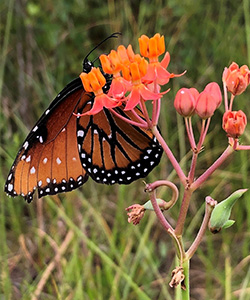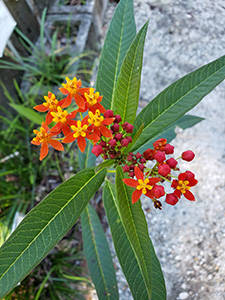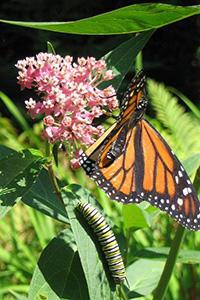Milkweed

Milkweed is the poster plant for pollinator gardens. Not only is it attractive, it’s an important nectar source for bees and other insects. Milkweed is also well known for attracting butterflies and serving as a host plant for their caterpillars.
Perhaps most famously, milkweed species serve as the host plant for the monarch butterfly. Milkweeds in the genus Asclepias provide the only plant material monarch caterpillars can eat. And this popular plant hosts many more besides monarchs. Queen and soldier butterflies rely on the leaves to feed their young, too.
The Sunshine State is home to more than twenty species of milkweed, almost all of which are native. A couple of these species, in fact, are endemic, meaning they’re found only in our state.
Two milkweed species are commonly offered for sale as “butterfly garden plants.” Butterflyweed (Asclepias tuberosa) is native to Florida. The other, non-native tropical milkweed (Asclepias curassavica) was recently assessed as invasive and no longer recommended. Read on for more information about native and non-native milkweeds.
Native Milkweeds

Unless you visit a nursery that specializes in native plants, you are unlikely to find more than one native milkweed species for sale. Still, we think the rewards make these species worth the search. Adding these natives will make your landscape a refuge for Florida’s flora and fauna.
Butterflyweed, Asclepias tuberosa, is one of the most available and popular native species of milkweed. It sports attractive, bright blooms and is very hardy. For these reasons it is frequently stocked in nurseries around the state. Butterflyweed grows as a perennial in USDA Hardiness Zones 3-10a. From late summer through early fall it produces orange or yellow flowers. A. tuberosa’s vibrant colors make it attractive to a number of pollinators.
Other native milkweeds are available as well. A list is provided at the bottom of this article, taken from the Atlas of Florida Plants. You may have to seek them out in nurseries that specialize in natives or butterfly gardens. But for a pollinator-friendly garden, we think it’s worth the effort.
Non-native Milkweed

In many nurseries, the most readily available species of milkweed happens is a popular but non-native one. Tropical milkweed (Asclepias curassavica) produces bunches of orange, yellow, and red tubular blooms for months. Asclepias curassavica has recently been assessed as an invasive species in Florida and is not recommended by UF/IFAS. More information is available through the UF/IFAS Assessment of Non-Native Plants.
This species is often confused with native butterfly weed (Asclepias tuberosa), which looks quite similar. The easiest way to tell them apart is the color differentiation; butterflyweed has orange-yellow flowers with some red coloration on the petals, while tropical milkweed has red flowers with some yellow coloration. Sometimes tropical milkweed is mislabeled “butterfly weed” or simply “milkweed.” Check the label for the scientific name to avoid confusing this plant with native milkweed species.
Scientists are divided over tropical milkweed’s value to monarch preservation. Its year-round growth may encourage monarchs to overwinter instead of following their normal migration pattern. Some studies suggest that overwintering puts monarch populations at a higher risk for certain diseases. Tropical milkweed also has a higher concentration of cardenolides, which may affect monarchs in the caterpillar stage of their life cycle. On the other hand, some scientists point out that the most pressing threat to monarchs is extreme habitat loss. Tropical milkweed’s ubiquity in Florida landscapes may help the monarchs regain territory.
Planting and Care

Most milkweeds prefer full sun. They tolerate a wide variety of soil conditions, from clay to sand. Many Florida species used in the landscape prefer dry, sandy soil and are moderately drought tolerant.
Milkweeds generally grow quickly, reaching a final height of one to four feet tall, depending on the species. You can plant them closely, about 18-24 inches apart. And whether or not the milkweed is being installed as part of a butterfly garden, plant multiple plants. Too few and you will be left with leafless milkweed and hungry caterpillars! Planting multiple species can also increase the attractiveness to butterflies and other pollinators.
As a host plant for a number of pollinators, use of pesticides on milkweed is discouraged. As a result, expect some aesthetic damage throughout the growing season. Install milkweed behind ground covers or mounding plants to hide the stems but show off the blooms. Monarch caterpillars can consume a plant’s leaves quickly, but do not usually damage the plant long-term. Aphids can also cause damage. Keep these in check with a blast of water from the hose instead of applying pesticides.
Milkweeds get their common name from the milky sap they exude. This sap can irritate skin and is toxic if consumed in large quantities. Keep pets and small children away.
For more information about milkweed and other pollinator species, contact your county Extension office.
Milkweed Species Native to Florida
* Learn more about plants with an asterisk in our article on native milkweeds
- Asclepias amplexicaulis – clasping milkweed
- Asclepias cinerea – Carolina milkweed
- Asclepias connivens – largeflower milkweed
- Asclepias curtissii – Curtiss’ milkweed
- Asclepias feayi – Florida milkweed
- Asclepias humistrata – pinewoods milkweed*
- Asclepias incarnata – swamp milkweed*
- Asclepias lanceolata – fewflower milkweed
- Asclepias michauxii – Michaux’s milkweed
- Asclepias obovata – pineland milkweed
- Asclepias pedicellata – savannah milkweed
- Asclepias perennis – aquatic milkweed*
- Asclepias rubra – red milkweed
- Asclepias tomentosa – velvetleaf milkweed
- Asclepias tuberosa – butterflyweed; butterfly milkweed*
- Asclepias variegata – redring milkweed
- Asclepias verticillata – whorled milkweed*
- Asclepias viridiflora – green milkweed
- Asclepias viridis – green antelopehorn*
- Asclepias viridula – southern milkweed; green milkweed

